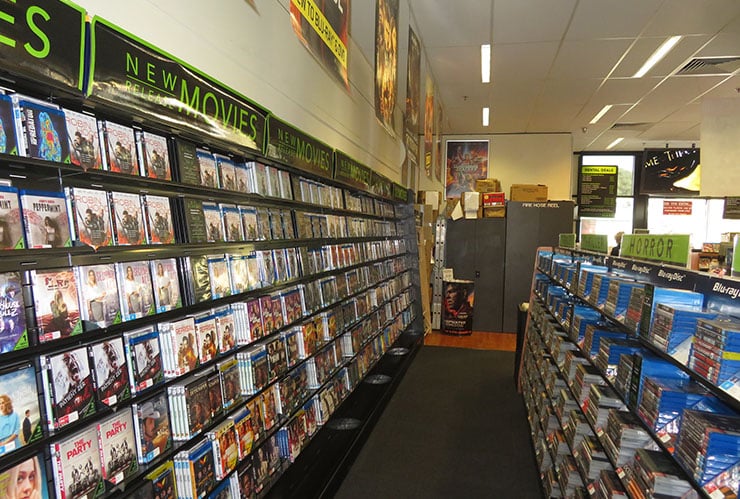Fridays were special growing up. Mom and Dad would drive my sister and me to Video Playhouse. It was our small-town version of Blockbuster, housed in a building with a false Western façade amid what passed for our dusty “downtown.”
I recall the excitement of navigating to my favorite sections in the store: action and horror. My parents were permissive about what we could watch, in part because it was limited, anyway. The building always felt like a cool oasis, a respite from the scorching summers of Southern California. I remember the scent and the sound of those plastic snap-close cases and the intriguing cover art inviting us to watch and see more. Each of us would usually be allowed to take home one movie and, in my case, also a console game. Three days to slay the dragon.
It was a ritual—consumerist, sure, but a family ritual, nonetheless. It was an outing, a social engagement within our community, a gathering at a real place to which we had traveled together and where chance encounters with others we knew might occur. And yet I never could have imagined I’d come to miss it until I had my own kids after the advent of streaming services.
Call it the onset of Millennial nostalgia. Perhaps it is that. But I think this nostalgia is underpinned by a desire to resist the Amazon Priming of the world—where everything seems disembodied. People have said much about refusing to eat the bugs and live in pods but not enough about Elon Musk’s drive to condense life to an “everything app,” in which all social activities stand to be digitized and fed directly into your skull via a taxpayer-subsidized Neuralink brain implant. The future is bright and interconnected.
These days, you don’t have to leave your house to do much of anything—and fewer people do.
A recent study by the National Endowment for the Arts found that “significantly fewer American adults are attending cultural activities such as classical music concerts, theater productions and movies than they did before the coronavirus pandemic,” The Washington Post reported.
The decline in movie theater attendance predates the pandemic, and it could be attributed to various factors, including substandard offerings. But it’s undeniable that on-demand streaming played a part in that as much as it has in the death of brick-and-mortar video rental stores.
The last chain, Family Video, closed in 2021, shortly after I moved to the Midwest, where most of its stores were based. In my town, a vape shop took its place because that’s one thing, unfortunately, no one has figured out how to digitize and thus remove from the public’s sight.
Blockbuster grew from a single store in Dallas to a chain of 9,000 locations. As of 2023, only one store remains, in Bend, Oregon, as an outpost of the past. In a testament to the power of nostalgia, that store claims 4,000 active accounts and has fresh sign-ups each day, including people who travel hours just to see the building.
Indeed, the demise of the rental stores has been met with a simultaneous renewed interest in for physical media. Evil Dead II, originally released in 1987, recently emerged from the grave with a new VHS release last November. The creators of the hit sci-fi horror show Stranger Things have discussed reformatting the first season of the show to appear if it were produced for VHS. You can already buy DVD and Blu-ray editions of the series that come in video cassette-inspired packaging.
I suspect that this trend is indicative of the pendulum swinging in the other direction. A consumer sentiment study published this year reported that 62 percent of respondents agree there are too many streaming choices, and fewer are renewing their subscriptions. This flies in the face of our longstanding cultural assumption that more choice is better. In an age when you don’t even have to get off the couch to have the world’s media at your fingertips, more people are missing a time with fewer choices.
I’m reminded of another study conducted by social scientists on whether affluent societies are necessarily happier ones. They made a distinction between “maximizers” (“those who always aim to make the best possible choice”) and “satisficers” (“those who aim for ‘good enough,’ whether or not better selections might be out there”).
In short, they concluded that maximizers were generally less satisfied with their consumer choices despite being more likely to get what they wanted, when they wanted it. That’s the tyranny of choice. In contrast, their counterparts were generally happier with their choices despite having fewer options. It’s sort of like showing up at a movie rental store and being happy with what you take home, even when they don’t have the latest title.
Maybe things were less convenient and less sophisticated in the not-so-distant past, but that also meant they were more human, genuinely social, and therefore satisfying.
Even streaming giant Netflix seems to get this. Presumably, that’s why the company plans to open brick-and-mortar stores that, although not offering rentals, will offer dining and live entertainment. I doubt they will have quite the charm of the “Be Kind, Rewind,” stores Netflix killed off, though.
The rest of us can settle for buying a VHS player and amassing a trove of movie cassettes that were once part of our family rituals. We can’t “return,” as conservatives like to say—but we can choose to live simpler, happier lives.

Leave a Reply